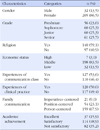Abstract
Purpose
The purpose of this study was to identify the relationship among the factors of self-awareness, other-awareness and communication ability, and how they relate to communication ability in nursing students.
Methods
For data collection 237 nursing students completed self-report questionnaires. Data were analyzed using independent t-test, one-way ANOVA, Pearson correlation coefficients, and stepwise multiple regression.
Results
Self-awareness, other-awareness and communication ability of the participants showed moderate levels of self-awareness, other-awareness, and communication ability. There were significant positive correlations between self-awareness and communication ability (r=.59, p<.001). and between other-awareness and communication ability (r=.22, p=.001). Social anxiety, private self-awareness, and internal other-awareness were significant factors, which explained about 37% of the variance in communication ability.
Figures and Tables
Table 3
The Degree of Self-awareness, Other-awareness, and Communication Ability according to General Characteristics (N=237)

References
1. Bramhall E. Effect communication skills in nursing practice. Nurs Stand. 2004; 29(14):53–59. DOI: 10.7748/ns.29.14.53.e93556.
2. Lee KJ, Ko SH, Lee S, Kim KH, Min SY, Choi YJ, Lee KH. Interpersonal and communication skills in nursing. Seoul: Hyunmoon;2014. p. 15–17.
3. Rosenberg S, Gallo-Silver L. Therapeutic communication: skills and student nurses in the clinical setting. Teach Learn Nurs. 2011; 6(1):2–8. DOI: 10.1016/j.teln.2010.05.003.
4. Hanifi N, Parvizy S, Joolaee S. The miracle of communication as a global issue in clinical learning motivation of nursing students. Procedia Soc Behav Sci. 2012; 47:1775–1779. DOI: 10.1016/j.sbspro.2012.06.899.
5. Bai JI. A study on the stress and recognition for psychiatric patients of nursing students during the clinical experience in the psychiatric unit. J Korean Acad Psychiatr Ment Health Nurs. 1999; 8(2):411–423.
6. Park JW, Choi MS. A study on self consciousness, communication competence, and interpersonal relation dispositions of nursing students. J Korean Acad Psychiatr Ment Health Nurs. 2009; 18(3):351–360.
7. Boschma G, Einboden R, Groening M, Jackson C, MacPhee M, Marshall H. Strengthening communication education in an undergraduate nursing curriculum. Int J Nurs Educ Scholarsh. 2010; 7(1):Article28. DOI: 10.2202/1548-923X.2043.
8. Park SW, Kim GM. Effect of self-consciousness and communication apprehension on interpersional communication competence of nursing student. Korean J Stress Res. 2011; 19(1):1–10.
9. Lee OS, Gu MO. The relationship between emotional intelligence and communication skill, clinical competence & clinical practice stress in nursing students. J Korea Acad Ind Coop Soc. 2013; 14(6):2749–2759. DOI: 10.5762/KAIS.2013.14.6.2749.
10. Lee SH, Chung SE. Influencing factors of critical thinking disposition and self-esteem on communication competence among nursing students. J Korea Contents Assoc. 2014; 14(12):340–349. DOI: 10.5392/JKCA.2014.14.12.340.
11. Ji EJ, Bang MG, Jeon HJ. Ego resilience, communication ability and problem-solving ability in nursing students. J Korean Acad Soc Nurs Educ. 2013; 19(4):571–579. DOI: 10.5977/jkasne.2013.19.4.571.
12. Park YS, Im SB, Kim HS. The effects of reinforced self-understanding in nursing communication curriculum. J Korean Acad Psychiatr Ment Health Nurs. 2009; 18(3):361–368.
13. Lee KS, Lee MK, Kim KH. Human relation & communication. Seoul: Hyunmoon;2012. p. 61–80.
14. Im SB. Communication education in nursing: To promote self-awareness. Health Commun. 2006; 1(1):59–66.
15. Silvia PJ, O'Brien ME. Self-awareness and constructive functioning: Revisiting 'The human dilemma'. J Soc Clin Psychol. 2004; 23:475–489. DOI: 10.1521/jscp.23.4.475.40307.
16. Engin E, Com O. Effect of self-awareness education on the self-efficacy and sociotropy-autonomy characteristics of nurse in a psychiatry clinic. Arch Psychiatr Nurs. 2009; 23(2):148–156. DOI: 10.1016/j.apnu.2008.05.003.
17. Oh YJ. The development and effectiveness of the communication empowerment program for nursing students based on the theory of transfer of learning [dissertation]. Seoul: Korea University;2008.
18. Eun HG. Adolescents self-awareness, other-awareness, interpersonal skills and the satisfaction of interpersonal relationship: The difference among the grades and between the sexes. Korean J Youth Couns. 2001; 9:136–157.
19. Im SB, Min BK, Goh JK. The relation between personality and interpersonal competence. Health Commun. 2007; 2(2):105–112.
20. Fenigstein A, Scheier MF, Buss AH. Public and private self consciousness. J Consult Clin Psychol. 1975; 43(4):522–527. DOI: 10.1037/h0076760.
21. Lee SJ, Chang YK, Lee HN, Park KY. A study on the development of life-skills: Communication, problem solving, and selfdirected learning. Seoul: Korean Education Development Institute;2003.
22. Asendorpf JB, Baundonniere PM. Self-awareness and otherawareness: Mirror self-recognition and synchronic imitation among unfamiliar peers. Dev Psychol. 1993; 29(1):88–95.
23. Jack K, Smith A. Promoting self-awareness in nurses to improve nursing practice. Nurs Stand. 2007; 21(32):47–52. DOI: 10.7748/ns2007.04.21.32.47.c4497.
24. Han KS, Park YJ, Kim KM, Oh YJ, Jin JH, Kang HC. Communication style, self efficacy, emotional regulation, and ways of coping among nursing students. J Korean Acad Psychiatr Ment Health Nurs. 2008; 17(1):28–34.
25. Xie J, Ding S, Wang C, Liu A. An evaluation of nursing students' communication ability during practical clinical training. Nurse Educ Today. 2013; 33(8):823–827. DOI: 10.1016/j.nedt.2012.02.011.
26. Hyun MY. The communication training needs of nurse in the university hospital. J Korean Acad Psychiatr Ment Health Nurs. 2002; 11(4):443–451.
27. Finke EH, Light J, Kitko L. A systematic review of the effectiveness of nurse communication with patients with complex communication needs with a focus on the use of augmentative and alternative communication. J Clin Nurs. 2008; 17(16):2102–2115. DOI: 10.1111/j.1365-2702.2008.02373.x.
28. Birkholz G, Clements PT, Cox R, Gaume A. Student's self-identified learning needs: A case study of baccalaureate students designing their own death and dying course curriculum. J Nurs Educ. 2004; 43(1):36–39.
29. Lee KS, Lee MK, Kim KH. Human relation and communication. Seoul: Hyunmoon;2006. p. 116–122.




 PDF
PDF ePub
ePub Citation
Citation Print
Print






 XML Download
XML Download